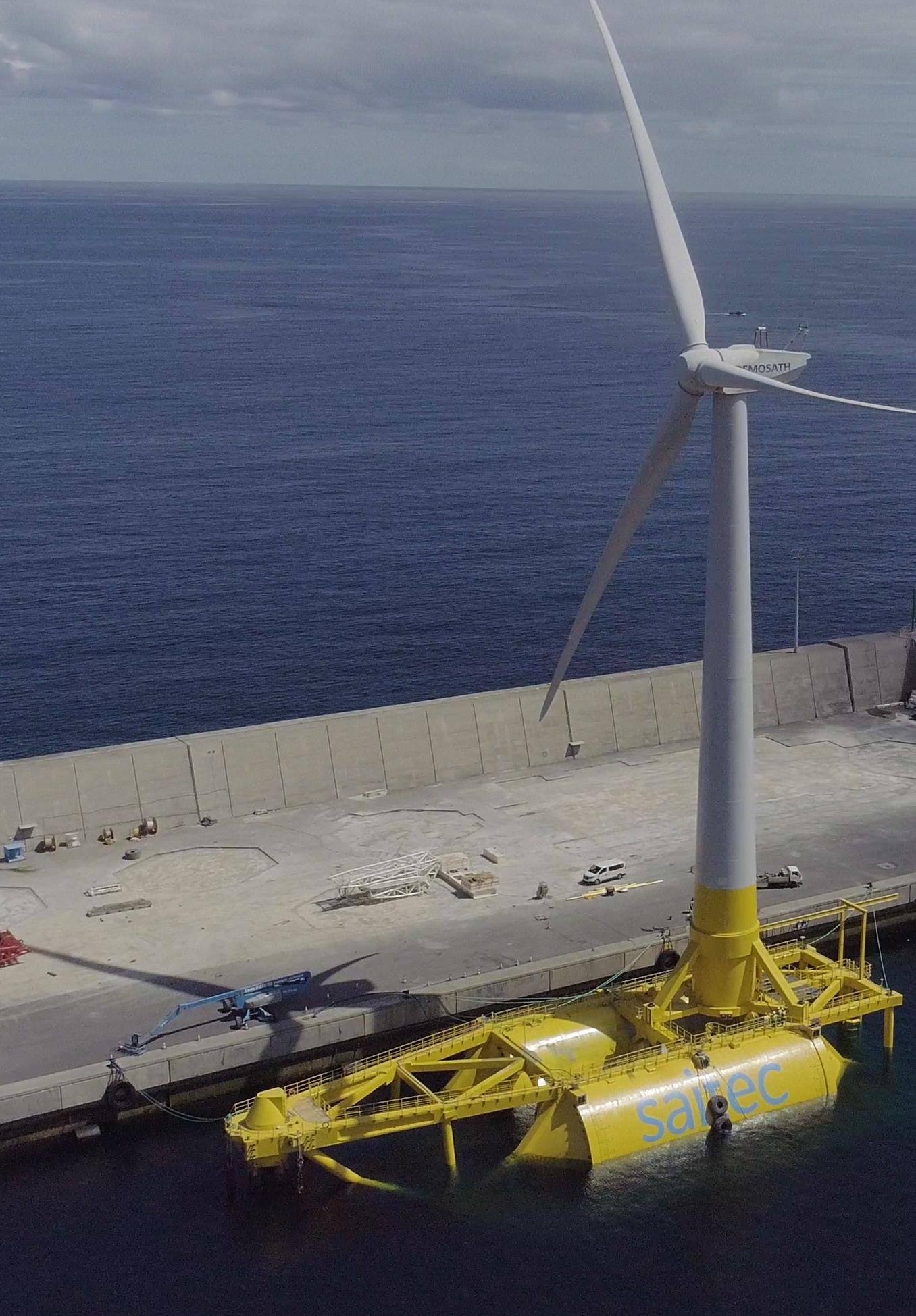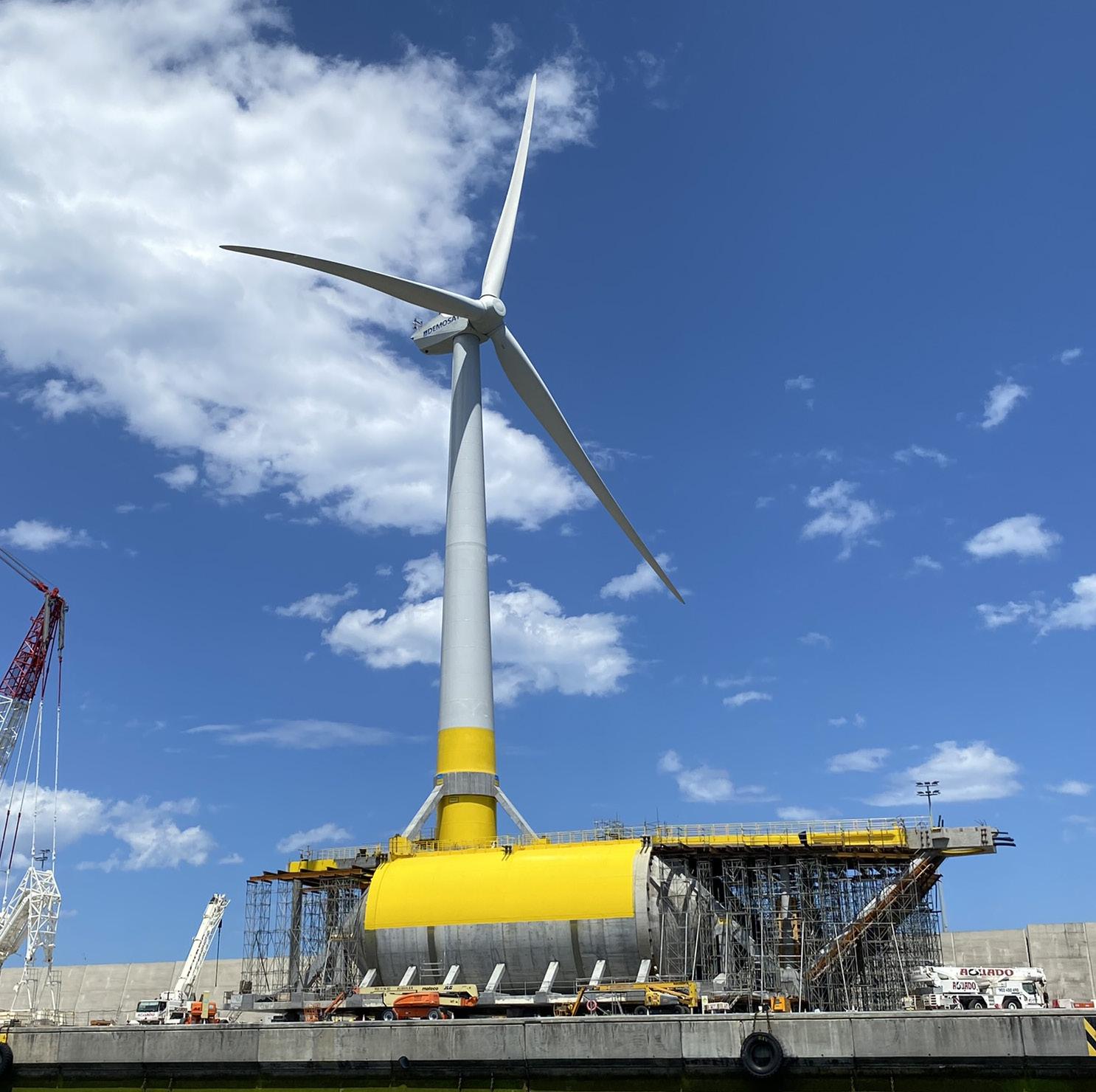
6 minute read
Leca is part of the solution for floating wind energy
1. Lightweight aggregate concrete (LWAC) has been used for a long time. One of the earliest uses of reinforced LWAC was in the hulls of ships and barges from around 1918 in the USA. Why is LWAC still an important solution in the infrastructure market today? And what has changed over the last 100 years with LWAC technology?

Advertisement
Well, we have the same challenges today as 100 years ago Ships and floaters need to float and to achieve this, lightweight materials achieve better buoyancy The weight of a concrete structure is still very dependent on the density of the material itself, so lightweight concrete offers a greater advantage The quality of the LWA has improved significantly during the last 100 years in strength, density, ratio and variation Today it is simple to make LWAC with a typical compressive strength of 60-70 MPa and still reduce the concrete density by 20-30% The variations in the quality of the LWA is very low today with uniform and fine pore structure, resulting in standard deviation figures which are lower than for similar normal density concrete, which is remarkable In addition, the binder system and reinforcement together with the knowledge on LWAC has improved The largest improvement in recent times is the addition of additives including super plasticizers which make LWAC even more innovative, and this includes LWAC offering self levelling and pumpability for easy delivery to site
2. Can we compare normal concrete with LWAC, so we can substitute normal concrete with LWAC in every project, in terms of concrete characteristics, price, and sustainability?
Yes and no
It is possible to substitute all normal weight concrete structures with lightweight concrete, but it is up to the Design Engineer to evaluate the benefits by doing so It is all in the design, how to design and construct a sustainable structure The LWA itself costs more than ordinary concrete aggregate, hence this will increase the concrete costs of the LWAC comparable

From recent projects, my experience tells me that LWAC comes in at a 1 5 to 2 times higher price, depending on the mix design and logistics It is therefore reasonable to use LWAC where you can find a benefit from the reduced weight and size of the construction And there are several types of projects Typical applications are floaters and structures with a long span . Here we can utilize the low weight and reduce the construction costs despite the higher unit price of the LWAC comparable The LWAC offers good mechanical characteristics and can cover the price differentials when compared to normal density concrete All designers should be able to calculate and design with LWAC
Regarding the question on sustainability, the answer is similar; reducing the weight of the structure and being able to construct longer, wider, and slimmer designs, whilst reducing the concrete structure itself, will generate an overall more sustainable structural design
3. Today, LWAC is widely used across the world as an alternative to normal density concrete (NDC). Can you please mention some of the key projects in recent times where Leca® LWA was used in the design?
I would like to highlight the Norwegian oil platforms and some of the world’s largest bridges with long spans This includes the Troll Oil and Gas platform which is a floater and a gravity-based platform with modified light weight concrete in the top shaft Two recent bridges built in Norway are also highly noteworthy; The Tryssfjord Bridge is a 537m long cantilever bridge with LWAC in the main span The current development at Nydal bridge in Trondheim is the first structure in Norway where we have pumped LWAC with pre saturated Leca® 800 I would also like to highlight the modern offshore windmill floater that was built in Spain recently by DemoSATH - we believe this structure is groundbreaking for floater design
1. One of the possible applications of LWAC is in offshore technologies, can you tell us more about it?

As Geir mentioned, there are many projects with Offshore projects; ships, oil tankers and even oil & gas extraction platforms such as Trollwest The use of lightweight concrete in a marine environment is recognized and proven, therefore this technology is applicable to the construction of floating platforms to support large wind turbines located offshore and in deep waters This technology allows the size of the wind turbines to grow since it will be able to house larger diameter rotors, thus being able to generate more green energy in a more sustainable way
We must be clear that this technology is under development and in the short/medium term we will be able to see 14 MW turbines with 222m diameter rotors Can you imagine the size of the floating platform that a wind turbine with a 222m diameter rotor needs? These dimensions are difficult to imagine, for sure, but you can easily think of the size of a football stadium, and you won't be too far from reality These are huge dimensions even for a single wind turbine but imagine the number of wind turbines it will take to reach the 17 6 GW that recent studies indicate will be needed by 2026

2. Can Floating structures be the solution to a greener electrical transition and guarantee a more sustainable future? Please share with us information on the DemoSATH – Saitec Offshore Technology project.
The energy transition to green energy is a reality We currently live in a scenario where energy is key to the development of our society and must be obtained in the most sustainable way
The DemoSATH is an innovative project The floating platform on which the wind turbine is installed is 30m wide and 64m long The rotor has a diameter of 96m The installed wind turbine produces 2 MW and it will be installed in the sea, off the coast of Bilbao The SATH (Swinging Around Twin Hull) technology consists of a catamaran-type double-hulled barge made up of two cylindrical floats of precast modular light weight concrete (LWAC) braced to each other and two submerged plates of the same material It is characterized by having a single anchoring point, which allows it to be aligned with the direction of the wind to make the most of the wind resource This prototype and technology are developed by the Spanish engineering company Saitec Offshore Technologies and has a very interesting design concept when compared to other prototypes that are being developed on the market
Its main characteristic, from the point of view of its construction, is that it has a design that allows for it to be assembled in its entirety in the port and then towed later to its location In other words, it does not require complicated and expensive assembly operations on sea, where working conditions are very difficult Through constructing a lightweight structure, the total assembled structure can be transported out of the construction harbor even on relative shallow waters
Furthermore, the construction of the windmills is simpler onshore, where good weather conditions are required to install the wind turbines If the selected technology allows the turbines to be installed very quickly, it will allow more units to start up and therefore generate greater profitability
We must also highlight that the DemoSATH pilot, due to its reduced weight of the total structure is a result of design- ing with lightweight aggregate concrete . This will allow these floaters to be built in a greater number of locations and ports around the world, improving the total sustainability of the design concept

Another important fact is that building lighter parts makes it possible to build larger geometries with reduced resources such a cranes and manpower We must not forget that these cranes in ports have very high costs and availability can be limited Therefore, moving excessively heavy parts could create a bottleneck in production performance
Sustainability is key for offshore windmill development Not only to produce green energy, but also the way the projects are designed and conducted at inception As mentioned by my colleague Geir Norden, the key to better sustainability is the design Using LWAC will allow the Design Engineer to optimize the design of the structure in many ways .
There are many characteristics that make the DemoSATH a very successful prototype of what this technology will be in the next 4 to 10 years
3. Innovation and sustainability go hand in hand for the future of large-scale engineering and this project was recognized with two awards, tell us more about them.
A project that consists of generating energy through wind turbines floating offshore in deep waters is certainly innovative This innovation has been recognized and has won awards as you have mentioned earlier
The first award for this project was for the material chosen to construct the floater; The lightweight concrete . This award was given by the ANEFHOP association (It is the association of the most important concrete producers in Spain) The second award was from the Federation of Aggregates (FdA) of Spain for the Sustainable Development Award in the category of Innovation and Climate Change
For LECA and Saint Gobain, it has always been of great importance to spearhead projects that, through innovation, new technologies and materials, allows us to take the next steps towards more sustainable solutions










